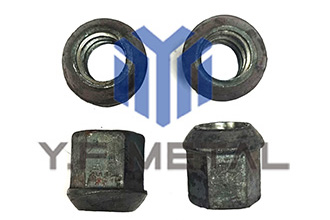Rock Bolt Nut: The Unsung Hero of Underground Rock Support
2025-09-02 20:45:59
By Admin
If you’ve ever swung a wrench in an underground job—mines, tunnels, slope work—you know rock bolts are the difference between a safe site and a disaster waiting to happen. But here’s the thing no one talks about enough: that bolt is useless without a rock bolt nut. It’s the tiny, tough piece that locks everything down, turning a plain metal rod into something that can hold back tons of rock. I’ve seen crews cut corners on nuts to save $50—and end up shutting down for a week when half the bolts came loose. Trust me, this little part isn’t worth skimping on.

What Even Is a Rock Bolt Nut, and Why Does It Matter?
Let’s keep it simple—no engineering jargon. A rock bolt nut is just the threaded fastener you screw onto the end of a rock bolt. Pair it with a washer (flat or domed, depending on the job), and it clamps the bolt tight against the rock or a bearing plate. But it’s not just “twisting something on”—here’s why it’s non-negotiable:
- Locks in Tension: Tighten the nut, and it pulls the bolt taut—creating pressure that glues the rock together. Skip a tight nut, and that bolt’ll wiggle loose over time. I had a crew in New Mexico ignore this once; a section of tunnel wall shifted 6 inches before we caught it. Lucky no one was hurt, but we spent 2 days redoing all the bolts.
- Spreads Pressure So Nothing Breaks: Without a nut (and washer), the bolt’s force concentrates on one spot. Soft rock? It’ll sink right in. Last year, we used undersized nuts on a shale slope in Colorado—they punched through the bearing plates like they were paper. Switched to proper-sized nuts, and problem solved.
- Takes a Beating Underground: Moisture, dust, constant shaking from equipment—underground’s brutal. A good nut won’t rust, won’t strip if you fumble the wrench, and stays tight even when the rock creaks a little. I’ve got nuts in a Utah mine that’ve been there 7 years—still as solid as day one.
The Different Types of Rock Bolt Nuts (And When to Use Each)
Nuts aren’t one-size-fits-all. Pick the wrong one, and you’ll be redoing work at 2 a.m. Here’s what I actually use on jobs, and why:
1. Hexagonal Nuts (The “Everyday” Choice)
These are the ones you’ll see in most trucks—six sides, easy to grab with a standard crescent wrench, and cheap. They’re perfect for basic jobs: mine walls that aren’t too soft, tunnel linings, highway slopes. Last summer, we used them on a Utah highway slope—200 nuts, installed in 4 hours, no drama. The only problem? Tight spaces. I worked a 3-foot-tall tunnel in Idaho once—couldn’t get a wrench around a hex nut to save my life. Had to switch to something slimmer.
2. Dome Nuts (For Soft or Fragile Rock)
Dome nuts have a rounded top instead of flat sides. Why does that help? They spread pressure way better than hex nuts—critical for soft stuff like shale or porous limestone. I had a crew in Colorado drilling through sandstone that crumbled if you looked at it wrong. Hex nuts sank right in, bolts loosened overnight. Switched to dome nuts, and suddenly the support held. Bonus: They’re harder to strip—my guy Jake once dropped a wrench on a dome nut, and it still didn’t mess up the threads. Only downside? They cost about 10 cents more each. Worth it to avoid rework.
3. Lock Nuts (For High-Vibration Areas)
If your site’s shaking nonstop—coal mines with longwall machines, tunnels near busy highways—lock nuts are a must. They’ve got a built-in washer or a weird thread design that keeps them from coming loose. I used them in a Wyoming coal mine where the equipment vibrated so hard, hex nuts would loosen every 3 days. With lock nuts? We check ’em once a month, max. Pro tip: Pair ’em with a flat washer—keeps the vibration from wearing down the threads. I forgot that once, and 10 nuts stripped in 2 weeks. Oops.
4. Wing Nuts (For Quick, Temporary Support)
Wing nuts have two little “arms” you can twist by hand—no wrench needed. They’re for emergencies or temp jobs: holding up a temp tunnel lining while you install permanent bolts, fixing a loose section fast. Last quarter, a mine wall in Arizona started to crack—we grabbed wing nuts, got bolts in, and stabilized it in 10 minutes. But don’t use ’em long-term. I had a crew leave wing nuts on a slope once—rain hit, they loosened, and we had to redo 30 bolts. They’re a Band-Aid, not a solution.
How to Choose the Right Rock Bolt Nut (Avoid Costly Mistakes)
I’ve wasted days fixing nut mistakes. Here’s what I tell my crews to do—no guesswork:
1. Match the Nut to the Bolt (Thread Size Matters!)
This sounds stupid, but I still see it. If your bolt is M20 (20mm threads), use an M20 nut. Last year, a crew in Oregon used M18 nuts on M20 bolts—stripped 50 bolts, shut down the mine for 3 days. Cost ’em $12k in lost time. Check the bolt—most have the size stamped on the end. If not, grab a thread gauge (we keep one in every truck) and measure.
2. Pick the Right Material (Fight Rust and Wear)
Moisture underground kills nuts. Dry tunnels? Carbon steel works. Wet or salty spots—coastal tunnels, mines with underground water—use stainless steel. I had a project in Washington near the ocean: carbon steel nuts rusted in 6 months, stainless ones are still good 3 years later. On a budget? Zinc-plated nuts are better than plain carbon steel, but not as good as stainless. I used zinc-plated on a dry Nevada mine—held up 4 years, no rust.
3. Don’t Skimp on Quality (Cheap Nuts Cost More Later)
It’s tempting to buy \(20 boxes of nuts from Amazon. Don’t. I had a client in Arizona do that—no-name hex nuts. Within 2 months, half had stripped threads. We shut down the mine for 3 days to replace ’em—cost \)10k. Buy from brands that follow ISO 898-2 (metric) or ASTM A563 (imperial). We use Stanley or DeWalt—they’re a little pricier, but no more midnight repairs.
4. Think About the Installation Space
If you’re hunched over in a tight tunnel, a big hex nut won’t work. Go for thin-profile hex nuts (slimmer than regular) or dome nuts—you can use a socket wrench instead of a crescent. In that Idaho tunnel I mentioned? Thin-profile hex nuts were the only way we got the job done. We kept a box of ’em in the truck after that—you never know when you’ll need ’em.
Common Mistakes to Avoid When Installing Rock Bolt Nuts
Even good nuts fail if you install ’em wrong. Here’s what I yell at my crew about (lovingly):
1. Over-Tightening (You’ll Strip the Threads!)
Everyone thinks “tighter is better.” It’s not. Too much force strips the nut or bolt. We use a torque wrench—most nuts need 50–80 N·m. For M20 bolts? 65 N·m is perfect. No torque wrench? Tighten until it’s snug, then give it a quarter turn. Don’t crank it like you’re trying to break it. Jake did that once—stripped 3 nuts in 5 minutes.
2. Forgetting the Washer
Washers aren’t optional. They keep the nut from sinking into soft rock and protect threads. I saw a crew skip washers on a shale tunnel—nuts sank in a month, bolts loosened. We had to pull all 100 bolts and redo ’em. Always use a washer the same size and material as the nut—stainless washer with stainless nut, carbon with carbon.
3. Ignoring Rust or Damage
Before you install a nut, check it. Rust? Bent threads? Crack? Toss it. A rusted nut won’t screw on straight, a cracked one’ll break when you tighten it. We sort nuts before every job—takes 5 minutes. Last year, we found 12 rusted nuts in a box—would’ve been a disaster if we used ’em.
Where Rock Bolt Nuts Shine (Real-World Applications)
Nuts are everywhere, but these are the jobs where they matter most:
- Mines: Coal, metal, mineral—anywhere the roof could cave. Lock nuts all the way—vibration kills regular nuts.
- Tunnels: Road, rail, water—hex nuts for standard linings, dome nuts for soft rock. We used dome nuts on a California water tunnel—soft limestone, no issues.
- Slope Stabilization: Highways, dams—hex nuts with washers. Keeps bolts tight even when the slope shifts a little.
- Underground Caverns: Storage, data centers—stainless steel nuts. Moisture’s a problem, and we don’t want to redo bolts every year.
Final Thought: Don’t Overlook the Nut
Rock bolts get all the praise, but the nut’s the real hero. I’ve seen \(100 bolts fail because of \)2 nuts, and $20 bolts hold because of good nuts. When you’re planning a job, take 5 minutes to pick the right nut. Match the material to the weather, the size to the bolt, and don’t buy cheap.
If you’re not sure? Call a supplier who’s been in the game. Tell ’em your rock type, how wet it is, and what tools you’re using. They’ll point you to the right one. Trust me—when your support holds strong and you’re home for dinner instead of fixing bolts? You’ll be glad you cared about the small stuff.




